Your cart is currently empty!
Rookwood Pottery Marks – How to Identify Rookwood
Published:
Last Updated:

Affiliate Disclaimer
As an affiliate, we may earn a commission from qualifying purchases. We get commissions for purchases made through links on this website from Amazon and other third parties.
One way to identify a piece of pottery is the maker’s marks which are usually on the base. Rookwood Pottery marks have changed quite a bit over the years. And it’s helpful if you want to get hold of some Rookwood pieces to know what to look out for. Here is the information you need if you want to identify Rookwood Pottery.
The iconic Rookwood pottery mark is a reversed ‘R’ joined to the letter ‘P’. Flame marks radiate out from the ‘RP’ letters to denote the year the piece was made. However, after 1900 additional letters were used to indicate later years. Other letters and shapes were also used to convey further information about the piece, for example, the artist or the shape of the piece.
Spotting the ‘RP’ sign with its radial flames may help you know that you are looking at a piece of Rookwood. But knowing more about the other markings will give you more exact information about the item, so read on…

Early Rookwood Pottery Marks
Rookwood Pottery was founded in 1880. It wasn’t until 1882 that Rookwood started marking its pottery in a systematic kind of way. In the first two years of production, they used a number of ways of signing off their pieces.
If you are lucky enough to come across some very early Rookwood Pottery, here are some of the marks you might see.
Hand Signed Marks
Before 1882, pieces were sometimes signed with the details being painted on the base in underglaze. Alternatively, the artist would carve (also called incising) their initials and the name Rookwood Pottery onto the base. Sometimes they added the date too.
Here is an example of the hand signature that was used.

Smithsonian Libraries, Public Domain.
Alternatively, the piece might be signed as follows:

Smithsonian Libraries, Public Domain.
The lettering stands for Rookwood Pottery, Cincinnati, Ohio. And in this example, the initials RLN stands for Maria Longworth Nichols as the artist. Maria was also the founder of Rookwood Pottery.
Stamped Marks
Pieces in the first two years were not always hand signed. Sometimes the signature was impressed into the clay, either as a stamp or in relief.
Here are some of the rare stamp marks used on early Rookwood Pottery.
This anchor icon was used either as a stamp or in relief and was used on pieces before 1883.

Smithsonian Libraries, Public Domain.
This scroll icon, which reads Rookwood Pottery Cin, was rarely used.

Smithsonian Libraries, Public Domain.
An icon with a kiln and rooks was sometimes stamped onto bisque ware with color.

Smithsonian Libraries, Public Domain.
Alternatively, this small kiln icon was impressed into the clay before biscuit firing.

Smithsonian Libraries, Public Domain.
Another stamp that was also sometimes used in the first couple of years read ‘Rookwood Pottery, 207 Eastern Avenue, 1882, Cincinnati’. This text was written in capital letters and positioned within an oval shape.

Smithsonian Libraries, Public Domain.
So, there were several ways that Rookwood Pottery was marked in the first couple of years. However, in 1882, the pottery started to mark their pieces with a block stamp, that read ‘Rookwood’ in capital letters. The year was also added beneath the pottery name.
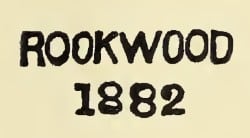
Smithsonian Libraries, Public Domain.
The mark was impressed into the clay. The year on the stamp was written in Arabic numerals, rather than Roman numerals, and it changed annually until 1886.
Rookwood Pottery Marks from 1886 Onwards
In 1886, Rookwood changed its pottery mark from the block stamp. Instead, they used the initials RP for Rookwood Pottery and created a stylized design. The R was reversed and the spine of the R and P were combined creating this marking.

Smithsonian Libraries, Public Domain.
From 1886 onwards the company continued to use this design of its initials as pottery mark. However, in 1887 they added a single flame to the top of the icon.
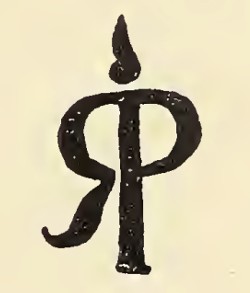
Smithsonian Libraries, Public Domain.
Each year they added another flame to the icon. As the years went on the flames gradually spread around the RP letters from the top to the base.

Smithsonian Libraries, Public Domain.
They continued adding flames to the icon until a total of 14 flames had been by 1900. If you find a piece of Rookwood and you want to date it you can count the flames.
One thing to be mindful of is that the ‘tail’ on the R also looks like a flame. Be careful not to include that when you are counting the flame marks.
Rookwood Pottery Marks After 1990
Once Rookwood had stopped adding flames to their mark, they began to use Roman numerals under the stamp mark. The Roman numerals indicated additional years after 1900.
For example, if a piece was made in 1902, it would have 14 flames and the number 2 written in Roman numerals underneath.
Here is an example of a vase made in 1922. The RP marking has 14 flames around the top and the Roman numerals XXII are written underneath. XXII is 22 in Roman numerals, dating the vase 1922.

You will notice that there are other markings on the base of this vase. Each marking has a particular meaning and gives us further information about the piece.
So, let’s take a look at what these other marks mean now.
Additional Rookwood Pottery Marks
Here are some of the additional pottery marks that you might find on Rookwood.
Shape
Immediately underneath the Roman numerals was a number in Arabic numbers. This referred to the shape of the mold used. Some Rookwood pottery was made on the potter’s wheel, and some were made using plaster molds. You can read more about how Rookwood Pottery was made here.
Size
Next to the number that refers to the shape, there is often a letter ranging between A and F. This refers to the size of the piece. A particular shape may have been made in a range of sizes. The letter A indicated the largest size, and F was the smallest size. The shape would stay the same, but the size might vary.
Glaze Used
Rookwood was well known for its innovative glazes. Sometimes glazes were used on top of an artist’s decorative painting. And sometimes the glazes were used on their own, on hand-incised pieces, or production pieces from a mold.
Sometimes a letter was stamped into the base of the glaze to indicate which glaze had been used. For example, you might find the letter ‘V’ impressed into the base. This is an indication that Vellum glaze has been used.
The letter ‘G’ was sometimes used to indicate that Rookwood Sea Green glaze had been used. It is also said to have been used on ginger-colored clay (see below).
Artists Signature
Rookwood made what they called ‘Production Ware’. This was pottery that had been made from a plaster mold, which had not been hand decorated.
However, if a piece had been painted or incised by hand, it would often have the artist’s signature on the base. This is artist Sara Sax who started working at Rookwood in 1896 and worked there for 35 years.
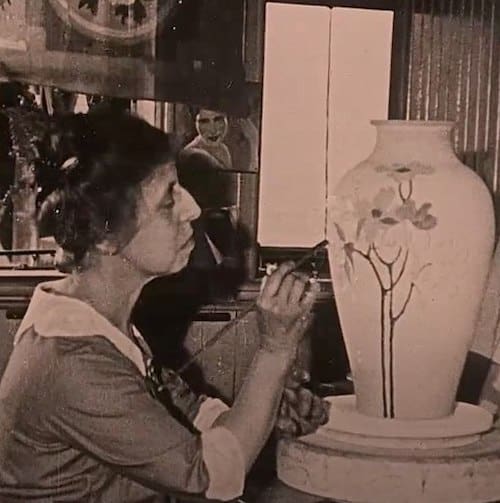
The artist’s signature was sometimes painted in underglaze, and often it was scored into the base by the artist. Generally, pieces signed by a specific artist are more valuable than those that are not.
Here are some of the Rookwood pottery artists and their marks:

Other Marks on Rookwood Pottery
You might find some additional marks on Rookwood Pottery. For example, some pieces have a marking to indicate the type or color of clay that they used.
Marks to Indicate the Type of Clay Used
‘P’ – Soft Porcelain
‘W’ – White clay body, also used to denote Iris Glaze
‘R’ – Red clay body
‘Y’ – Yellow clay body ‘S’ – Sage green clay body
‘G’ Ginger-colored clay
‘O’ – Olive-colored clay
Other letters that you might find on the base of Rookwood are:
‘S’ – Sometimes used to denote the use of sage green clay, an ‘S’ was also used on special pieces. Special pieces were sometimes one-of-a-kind pieces. However, the letter S also appears before some shape numbers. This indicates that rather than being made from the mold of that shape, they were made from a drawing of the shape.
‘Z’ – Trial shapes
‘X’ – The letter X was used in a few ways. If the X was ground into the glaze, this indicates that the piece was classified as a ‘second’, and not suitable to be sold. Alternatively, the X was part of the shape number, it indicates that the pot was a trial piece.
Finishers Marks
You may sometimes see dots, triangles, or crosses on Rookwood pottery marks. These are known as ‘finishers marks’.
A finisher’s mark is made by the person who adds details and ‘finishes off’ a piece. Those pieces may have been made on the wheel by another potter, or cast in a plaster mold.
Different finishers would place their mark at different points on the base of the piece.
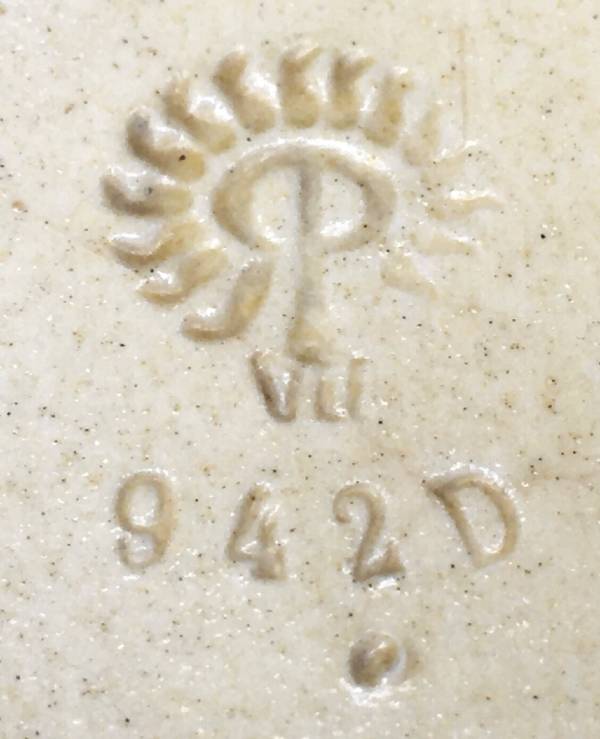
Rookwood Changes Hands
It’s sometimes said that antique and vintage Rookwood Pottery was in its prime towards the end of the 19th Century and the early part of the 20th Century (source).
Like many businesses of its time Rookwood Pottery struggled during the Great Depression which began in 1929. Rookwood managed to survive by increasing the number of production pieces that they made from plaster molds.
However, during the Depression and WWII, they had periods during which they laid off workers, and also times at which they closed periods. You can read more about the history of Rookwood Pottery here.
In 1941 they filed for bankruptcy, after which followed a series of ownership changes. In 1959 Rookwood was bought by the Herschede Clock Company.
Rookwood Relocates
Herschede was originally based in Cincinnati, but in May 1960 they moved to Starkville Mississippi (source). Rookwood Pottery, therefore, left Cincinnati and was relocated to Starkville.
During the time that Herschede owned Rookwood, they marked the base of their pieces with the words, “Rookwood Pottery Starkville. Miss”. This was impressed in addition to the flame icon, year number in Roman numerals, and shape number.
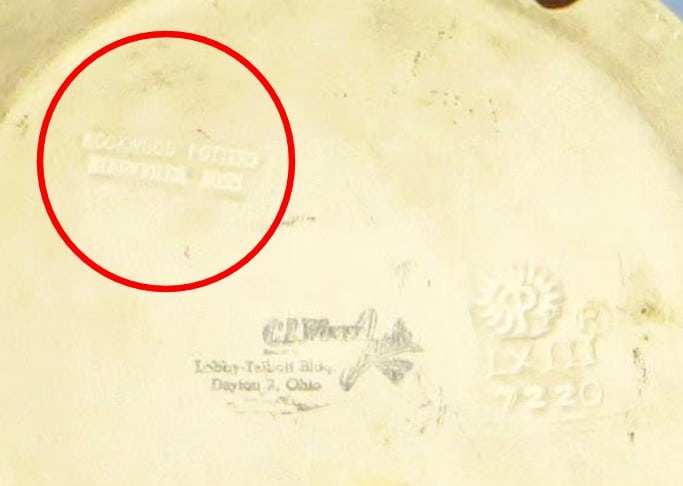

The Herschede company stopped manufacturing Rookwood Pottery in 1967, so they were only based in Mississippi for 6 years.
Rookwood Pottery Marks from The Townley Era
Rookwood Pottery remained dormant for 15 years. However, in 1982 a dentist from Michigan called Arthur Townley bought the Rookwood trademark and assets. Arthur and his wife Rita used the original Rookwood plaster molds to revive production. The objects that they made were mostly figurines.
Arthur Townley owned Rookwood Pottery for 23 years. During that time he and Rita made around 1000 pieces a year and made around 500 pieces from the molds they selected (source).
There are some other notable features of the Rookwood marks of that time. For example, the flame icon was used, however, the Townleys switched to using Arabic numerals to mark the date. The shape number was added underneath the year the piece was made.
In addition to this, the year and shape number was etched or scratched into the surface of the glaze.


Rookwood Pottery Marks Today
In 2005 Townley sold Rookwood and the pottery was moved back to Cincinnati where it remains today. Rookwood is located at a large production facility on Race Street in the Over the Rhine area of the city.
Since Rookwood has returned back to Cincinnati, the date is marked on the underside again with Roman numerals. If a modern piece of Rookwood has the date marked on it, it will begin with the letters MM which stands for 2000. For example, 2012 would be written MMXII.
Final Thoughts
Reading pottery marks can be like breaking a code. But once you have the key, the code usually isn’t too hard to crack. If you are lucky enough to buy a piece of vintage or antique Rookwood, I hope this overview will help you identify the marks on the base. Who knows, you may have a rare find.



